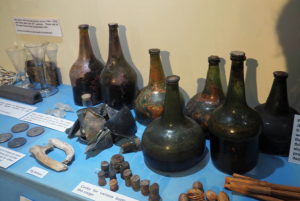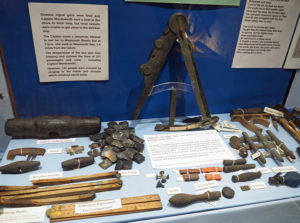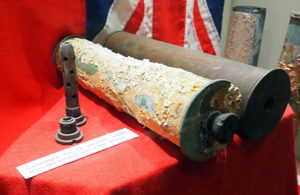The English Channel has always been one of the busiest shipping lines in the world. As well as collisions between vessels, and navigational errors and weather conditions led to many hundreds of wrecks. There is even a “website”:https://www.electricbluefishing.com/eb_sub_menu/shipwrecks_english_%20channel.htm dedicated to all the known wrecks.
Apart from the Shipwreck Centre and Maritime Museum on the Isle of Wight, this is the only dedicated Shipwreck Museum in Britain.
The Museum is in the heart of the Old Town, next to the Fisherman’s Museum. As well as the wrecks it also has a collection of fossils collected from along the coast.
There is information and artefacts from wrecks found from this stretch of the coast, including the Stirling Castle and the Anne. These were both built as part of “Samuel Pepys’s”:https://www.rmg.co.uk/stories/topics/samuel-pepys-navy ship building programme for Charles II.
In the mid c18th, The Dutch East India Company was the largest trading and shipping enterprise in the world, with its headquarters in Amsterdam. Ships sailed from the Netherlands carrying cargoes of wool, linen goods and wine as well as silver bullion to buy spices, silks and porcelain from the Far East for the return voyage.
The Amsterdam was built in 1748, and had about 50 guns to protect against enemies and pirates. She sunk on her maiden voyage after encountering severe storms in the English Channel. The remains of the wreck were discovered in 1969 and is still visible at low spring tides. It is the best-preserved wreck of an East Indiaman anywhere in the world.
The wreck is owned by the Dutch Government and protected by English Heritage. It is still visible at low spring tides. This is the best-preserved wreck of an East Indiaman anywhere in the world. A huge range of artefacts have been recovered from the wreck and are displayed in the museum.
There is also information about the Earl of Abergavenny built in 1796 for the East India Company fleet based in London and the Thomas Lawrence, a Danish Merchant ship and one of the last wooden sailing ships trading between Europe and Central America.
The most recent wreck in the museum is that of SS Storaa, which was built in Scotland in 1918 and passed through a series of owners before being bought by Denmark in 1939. In 1943 she was part of a convoy carrying tank parts from Cardiff and was attacked by German E-boats off the coast of Hastings and sunk. It is now designated as a war grave.
Also on display in the museum is part of a Roman ship, thought to be the remains of the oldest sea going vessel discovered in the Northern Hemisphere. Ships like this with their flat bottoms allowing cargoes to be loaded and unloaded on the beach, were probably used to transport iron made by small foundries in the Weald.
There are the remains of a C7th Saxon dug out canoe and the remains of a C15th sailing barge found wrecked in the River Thames.
In the yard at the rear of the museum is Primrose, the last of the Rye river barges, built around 1890 to a design that had hardly changed over the centuries. She was used to carry bulky cargoes and heavy goods from Rye to towns along the local rivers and waterways. Cargoes included timber, coal, hops, manure, sand, gravel, bricks, wool, and even livestock. Trade was lost to railways and later roads and Primrose was abandoned on the saltings at Rye harbour. She was submerged by the tide twice a day and her interior gradually filled with mud which helped preserve her. She was rescued in 1990 and transported to the Shipwreck Museum.
The Museum is open daily during the summer, but closed on Mondays. Tuesdays and Fridays from November to March. It is free but donations are appreciated. There is plenty of car parking at Rock-a-Nore Car park and the inside of the museum is DDA friendly.
Allow plenty of time for a visit as there is a lot to see. I had been worried it might be a bit ‘tacky’ but it wasn’t. This is a serious museum.
“Website”:https://shipwreckmuseum.co.uk/
There are a lot more pictures “here”:https://www.sloweurope.com/community/threads/hastings-and-its-fishing-heritage.6155/ here.










